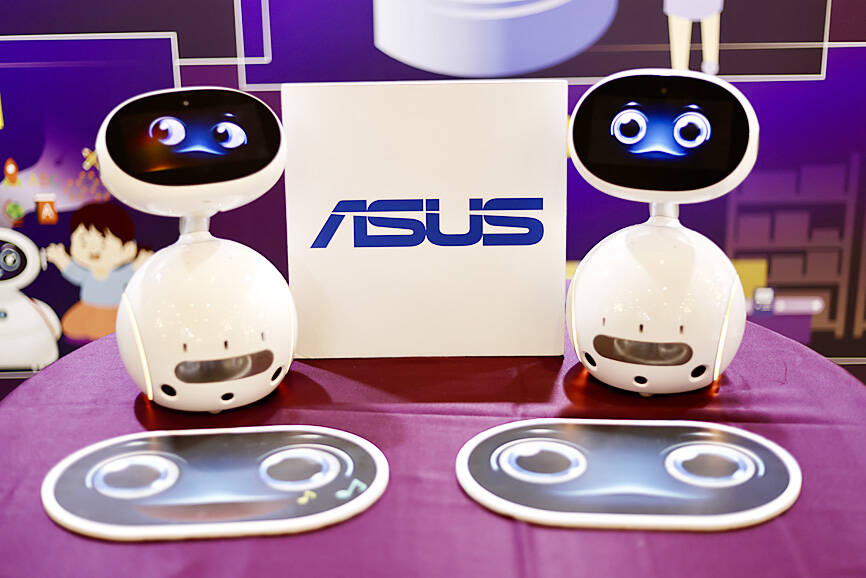Asustek Computer Inc (華碩), the world’s No. 5 PC vendor, yesterday reported an 87 percent slump in net profit for last year, dragged by a massive overdue payment from an Indian cloud service provider.
The Indian customer has delayed payment totaling NT$5.35 billion (US$162.7 million), Asustek chief financial officer Nick Wu (吳長榮) told an online earnings conference.
Asustek shipped servers to India between April and June last year.

Photo: Ritchie B. Tongo, EPA-EFE
The customer told Asustek that it is launching multiple fundraising projects and expected to repay the debt in the short term, Wu said.
The Indian customer accounted for less than 10 percent to Asustek’s total server revenue last year, he said.
Asustek’s net profit last quarter plummeted to NT$1.64 billion, compared with NT$12.5 billion in the previous quarter.
That represented an annual drop of 58 percent from NT$3.93 billion.
Earnings per share sank to NT$2.2 last quarter, from NT$16.8 in the previous quarter and NT$5.3 a year earlier.
The company’s operating margin missed its guidance, dipping to 0.7 percent last quarter due to the bad debts, from 7.1 percent in the third quarter and 2.1 percent in the fourth quarter last year.
Excluding the bad debts, its operating margin would have met its forecast of 4.5 percent, Wu said.
“We are confident that the company’s operating margin would rebound to between 4 percent and 5 percent for the full year,” Asustek co-CEO Samson Hu (胡書賓) said.
The first quarter of this year would be the trough since the PC market is undergoing a major shift to new platforms, such as Microsoft Corp’s new Windows 11 operating system and Nvidia Corp’s new RTX50 graphics processing unit series, Hu said.
That would be followed by a gradual improvement in the following quarters this year, he added.
Due to the platform adjustment, Asustek expects PC revenue to contract 20 percent sequentially this quarter, before expanding 30 percent next quarter, Wu said.
Revenue from its components, primarily motherboards and servers, is expected to drop 10 percent sequentially this quarter before rebounding 10 percent next quarter, he said.
Asustek expects its server business to make up about 15 percent of the company’s total revenue this year, up from about 11 percent to 12 percent last year, Hu said.
The introduction of low-cost artificial intelligence (AI) models by China’s DeepSeek (深度求索) would help accelerate the adoption of AI applications on edge devices such as AI PCs and stimulate demand for more AI computing power for pre-training, post-training and inferencing, given forecasts that the costs of AI models would plunge 10 times or even 100 times, he said.
“Even if post-training computing power demand should outpace that of pre-training, we do not expect demand to diminish,” Hu said, refuting concerns that the introduction of DeepSeek’s affordable AI models would reduce demand for applications powered by Nvidia’s AI chips.

Taiwan Semiconductor Manufacturing Co (TSMC, 台積電) last week recorded an increase in the number of shareholders to the highest in almost eight months, despite its share price falling 3.38 percent from the previous week, Taiwan Stock Exchange data released on Saturday showed. As of Friday, TSMC had 1.88 million shareholders, the most since the week of April 25 and an increase of 31,870 from the previous week, the data showed. The number of shareholders jumped despite a drop of NT$50 (US$1.59), or 3.38 percent, in TSMC’s share price from a week earlier to NT$1,430, as investors took profits from their earlier gains

In a high-security Shenzhen laboratory, Chinese scientists have built what Washington has spent years trying to prevent: a prototype of a machine capable of producing the cutting-edge semiconductor chips that power artificial intelligence (AI), smartphones and weapons central to Western military dominance, Reuters has learned. Completed early this year and undergoing testing, the prototype fills nearly an entire factory floor. It was built by a team of former engineers from Dutch semiconductor giant ASML who reverse-engineered the company’s extreme ultraviolet lithography (EUV) machines, according to two people with knowledge of the project. EUV machines sit at the heart of a technological Cold

Taiwan’s long-term economic competitiveness will hinge not only on national champions like Taiwan Semiconductor Manufacturing Co. (TSMC, 台積電) but also on the widespread adoption of artificial intelligence (AI) and other emerging technologies, a US-based scholar has said. At a lecture in Taipei on Tuesday, Jeffrey Ding, assistant professor of political science at the George Washington University and author of "Technology and the Rise of Great Powers," argued that historical experience shows that general-purpose technologies (GPTs) — such as electricity, computers and now AI — shape long-term economic advantages through their diffusion across the broader economy. "What really matters is not who pioneers

TAIWAN VALUE CHAIN: Foxtron is to fully own Luxgen following the transaction and it plans to launch a new electric model, the Foxtron Bria, in Taiwan next year Yulon Motor Co (裕隆汽車) yesterday said that its board of directors approved the disposal of its electric vehicle (EV) unit, Luxgen Motor Co (納智捷汽車), to Foxtron Vehicle Technologies Co (鴻華先進) for NT$787.6 million (US$24.98 million). Foxtron, a half-half joint venture between Yulon affiliate Hua-Chuang Automobile Information Technical Center Co (華創車電) and Hon Hai Precision Industry Co (鴻海精密), expects to wrap up the deal in the first quarter of next year. Foxtron would fully own Luxgen following the transaction, including five car distributing companies, outlets and all employees. The deal is subject to the approval of the Fair Trade Commission, Foxtron said. “Foxtron will be